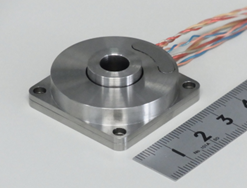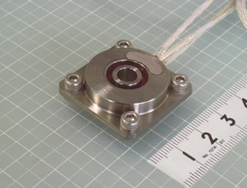Co-development with JAXA
(Modulated Wave Resolvers)
Selected as a Theme of Joint Research and Development
at JAXA Open Laboratory
The “JAXA Aerospace Open Laboratory“ aims to foster collaboration between JAXA, industry and the academic sector to promote joint research combining specialized technologies, ideas, and insights, of each and then to apply the fruits of that collaboration to such ventures as launching new businesses and aerospace projects.
Co-developed Products

Product external size: 35 mm x 35 mm
Resolution: 18 bit, 262144

Product external size: 30 mm x 30mm
Resolution: 4096
Joint Research Theme
Development of high environmental resistance, high accuracy, compact and lightweight modulated wave resolvers
Requirements (High environmental resistance)
・Operating temperature range: -50°C to +240°C
・Vacuum resistance and radiation resistance
Outline
Resolvers (absolute angle sensors) used to detect angles for satellites and other devices need high environmental resistance. Resolvers used in moon surface explorers calls for still further tolerance in areas such as wider temperature tolerance and dust resistance.
Modulated wave resolvers have very wide options for their materials, thanks to their simplified construction, since they form excitation/output patterns directly on their structure, unlike conventional resolvers that use wound coils.
This research endeavors to improve environmental resistance using heat resistant structural materials, and evaluates environmental resistance performance of the sensor area by conducting tests such as thermal vacuum testing.
Modulated wave resolvers with high environmental resistance rotation angle sensors, which will be developed through this research, will not only be applied in aerospace applications, but also in a wide range of consumer areas, such as airplanes, ships, automobiles, trains, semiconductor manufacturing devices, machine tools, and robots.

